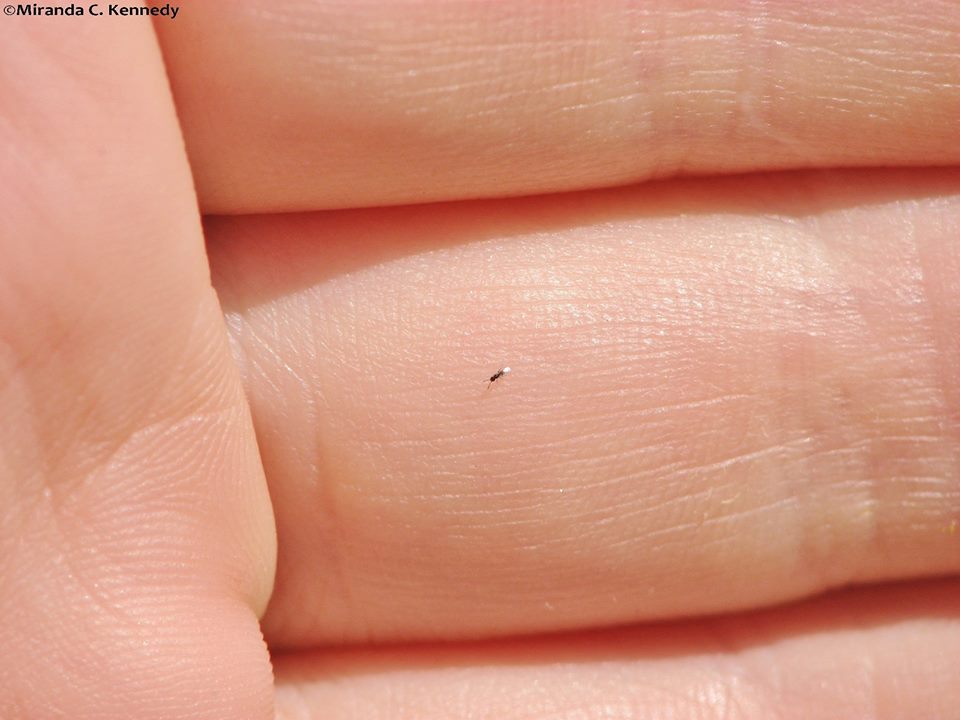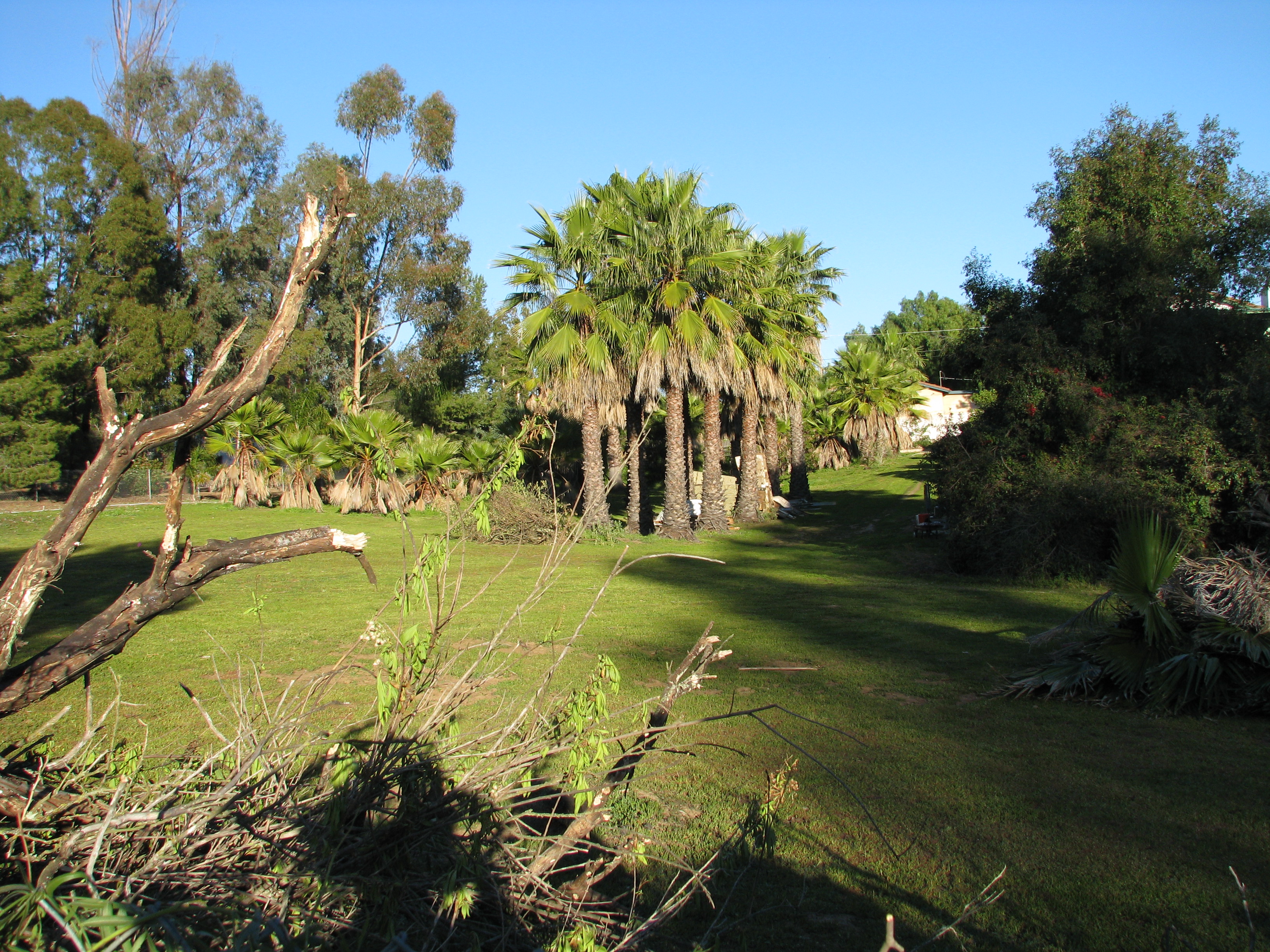Animals
-
Coyotes
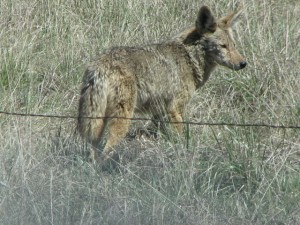
A coyote from some years back. Fall and winter are the times of year when many outdoor pets disappear. I’ve blogged on this before, too. ‘Teenaged’ coyotes, hungry (just like human teens!), bolder and less cautious will come closer to homes and people to grab food. If there is pet food outside the house, coyotes will take it if they can. If you have small pets outside, even chained, they can be killed by coyotes.
This doesn’t make coyotes evil. They are predators, a very necessary part of the food chain. Look up ‘trophic cascade’. That is how preditors in a wild environment cause prey animals to keep moving in natural patterns. Unthreatened, not only can prey animals reproduce to extremes, but also they will linger over feeding areas and eat plants down to the ground rather than trim them and move on.
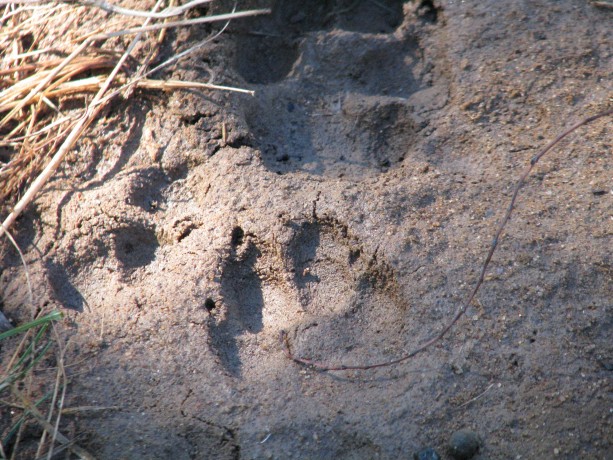
Coyote pawprints by the pond where they stopped for a drink. Dog pawprints have nails; cat (mountain lion!) pawprints don’t because their nails retract. Coyotes are intelligent, loyal, family-oriented, playful animals. They also make very scary sounds when howling and yipping in packs. Coyotes are no threat to humans unless the coyotes are sick, or if a child comes close when a coyote is eating outdoor pet food and is frightened.
Now that our last dog, Sophie, has passed away, coyotes are jumping the five-foot chainlink fence nightly and hunting in our yard. They have been unable to breach the Fowl Fortress (the hens are also locked into their coop within the FF for double protection). Unfortunately on Halloween I let the hens out of the coop about 45 minutes before dark. They had just gone under the Mock Pavilion, and I went into the FF to give Belle some of her special mash when there was a wild clucking. A coyote had come close and grabbed Chickpea our Americauna, and they were gone. My daughter saw it running away, and I dashed after, losing my slippers on the way, and hunted all over the neighbor’s yard but there was no sign of her.

It was tramatizing, and I kick myself because I should have known better, even though I was just yards away and the hens had been released only minutes before. It was a lucky chance for the coyote, who must have already been in the yard but hidden by plants. At least it was a quick death for our darling Chickpea. It hurts us both that she is gone. No more ‘outies’ for the girls, even with a hensitter.
The coyotes leave scat in our yard and we can tell what they’ve been eating.
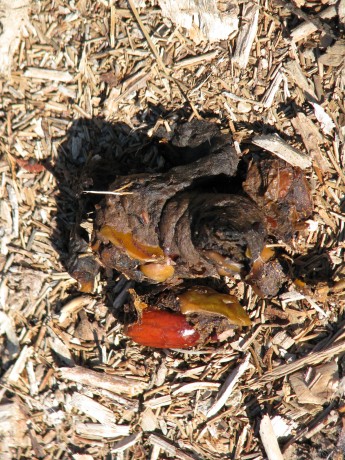
Sorry. Yes, it is coyote scat. Notice the seeds. Tiny seeds show that they were eating figs off of some volunteer fig trees down in the barranca. Larger seeds and skin in the scat shows that they are eating the red Eugenia berries in our yard. There is never much fur in the scat, so these omnivores have to scavenge to stay alive.
On the funny side, one day a few weeks ago I saw some fuzzy green thing in the yard.
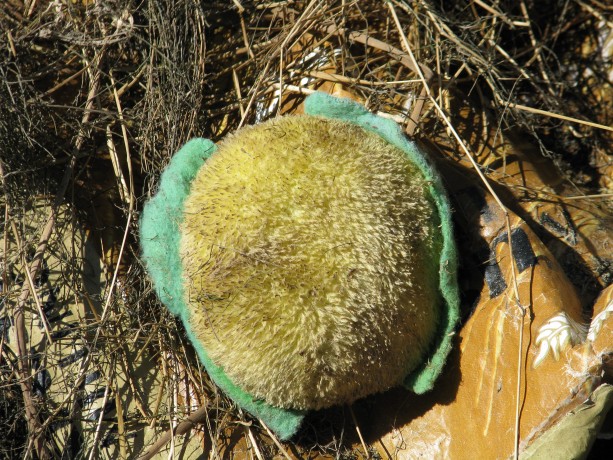
A coyote-delivered squeaky toy. It has since had its squeaker removed, and been slowly shredded by visiting coyotes. It turned out to be what looked like the center of a plush sunflower dog toy. It squeaked. It wasn’t ours. Some young coyote found it in another yard, carried it over the fence and played with it down by our pond. Over the next week it was moved around each night. One morning I found it next to a veggie bed I’d recently planted.
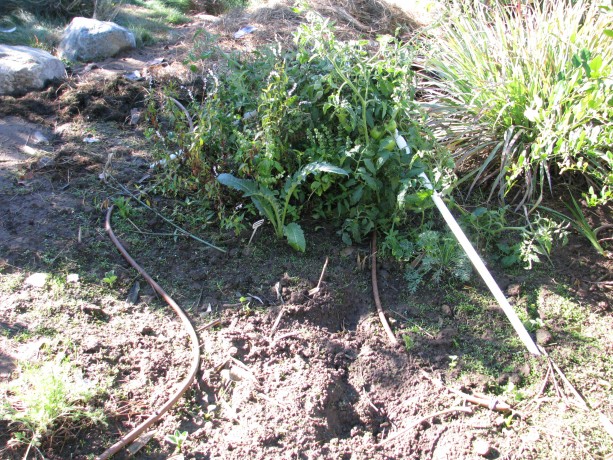
Where is my snake?? Then I realized that the rubber snake I put down in the bed to discourage birds was gone! My daughter and I looked everywhere for the snake, even for pieces of it, but it was gone! Some neighbor is going to have a real bad moment one of these days when walking through their property and they come across my rubber snake.
- Animals, Gardening adventures, Hugelkultur, Natives, Other Insects, Permaculture and Edible Forest Gardening Adventures, Ponds
Then and Now
This photo was taken just as work was begun on transforming the property into a garden, in February, 2011.
This photo was taken last Thursday, Oct. 31, 2013, from the same location.
This view may look weedy, especially in the early morning light on this brilliant Halloween morning. What you are seeing is the first bog, which is the green spot in the foreground. The dirt area is the overflow, if torrential rains ever come again. To the left, the tall bushes constitute the withy hide, and to the left is the big pond, although you have to take my word for it. Tall bamboo arches over the stumps of the palm trees in the above photo, which are trellises for roses and other vines. A nectarine branch is in the right foreground. The tall flowering plants are a native called fleabane. They reseed readily, and I allow them to because of several reasons. They grow five to six feet tall and help shade smaller trees and plants against the harsh summer sun, protecting them from sun scald. They also die off in the winter, making good hugelkultur material. The purple flowers, which are in the above photo now turning into fuzzy seed clumps, are attractive. The most important thing though is that they are excellent hosts for native insects of all kinds. Ladybugs, lacewings, spiders, and hundreds of tiny wasps and flies, many of which are parasitic, all love these flowers. All summer long they are alive with life. Inviting in the native pollinators, and growing a polyculture garden, is the first line of defense in growing naturally.
Allowing nature to define parts of your garden leads to happy surprises and lots of help from unexpected friends, such as bugs, birds and lizards. This kind of garden is endlessly interesting, with new things to study every day.
The following photos were all taken the same brilliant morning, Oct. 31, 2013. Here in San Diego county we were having what is called a Santa Ana, where warm, dry winds from the desert blow westward, as opposed to the more humid eastward flow of air from the ocean that we normally have. Santa Anas can bring heavy winds and make tinder-dry weedy hills a fire hazard, but this year we’ve been lucky and no major fires have happened. We even had almost 3/4 ” of rain, last week, which is practically unheard of for October. The warm Autumn sunshine was intense and lovely, and I had to take photos even though the light was too strong for good ones.
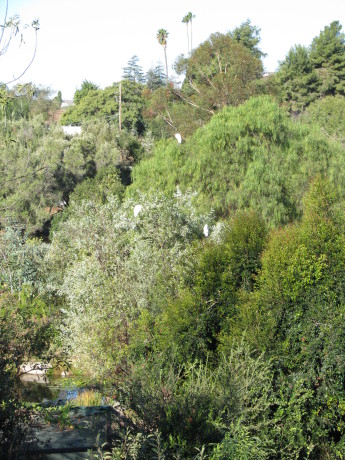
We went up on the roof to view these three greater egrets perched in our trees over the pond. 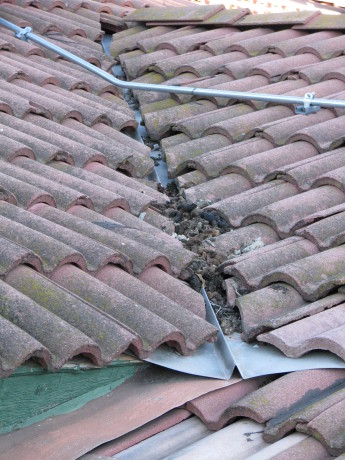
Being on the roof is an education. Here is lots of racoon poo between the tiles. Why?! 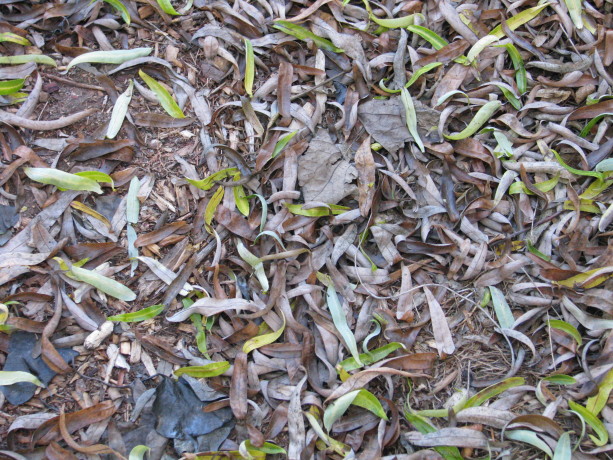
We don’t have dramatic Fall colors here, but the subtle Autumn hues of leaves is lovely. 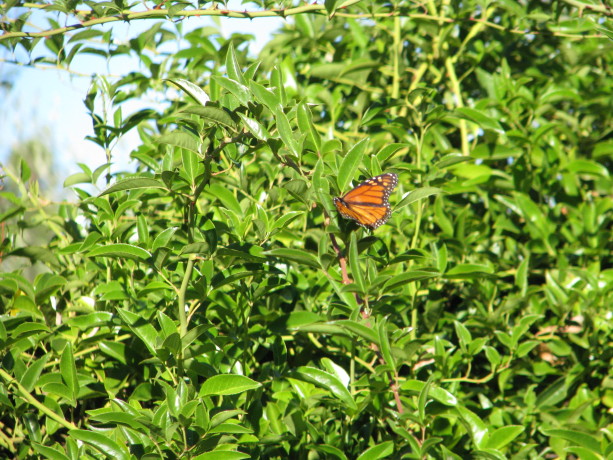
We still have Monarch butterflies. 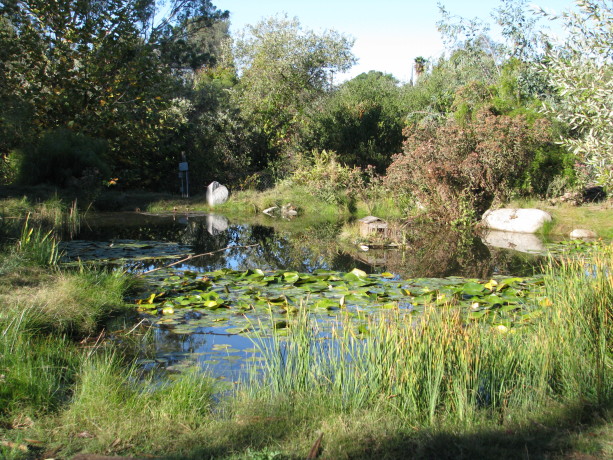
The big pond in early morning light. 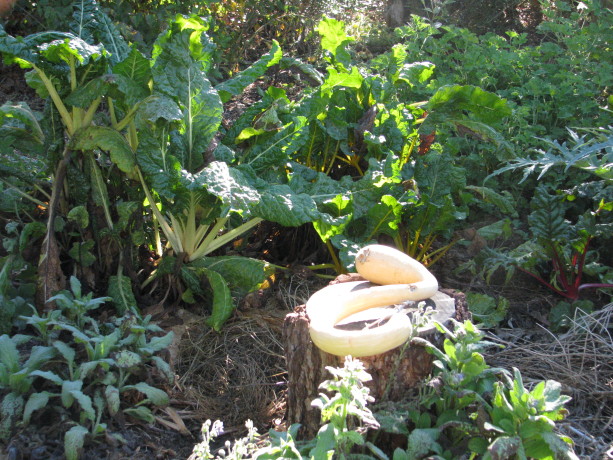
A zuchianno rampicante reclining on a stump. (Its a squash!). 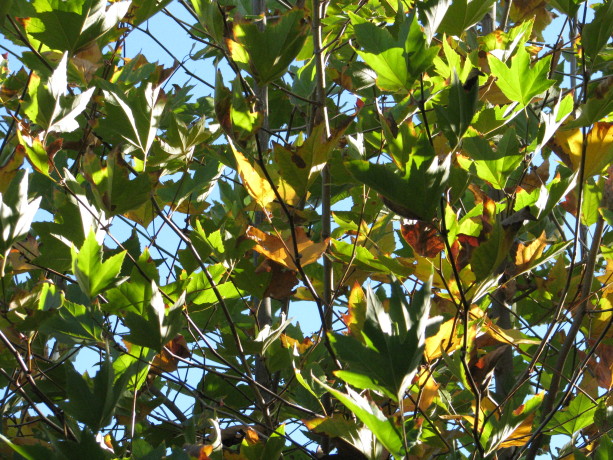
Morning sun through a Fall-leaved sycamore. Beautiful. 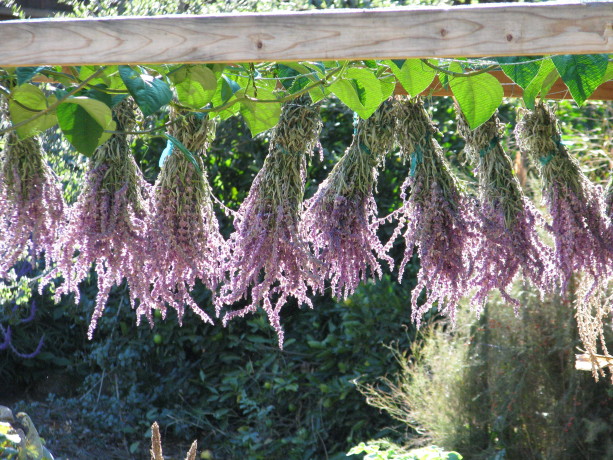
Mexican bush sage hanging up to dry. 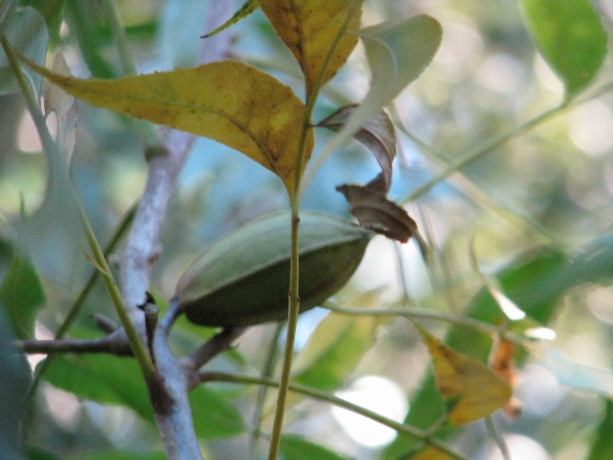
Our little pecan tree put on about six this year! Next year, tons! 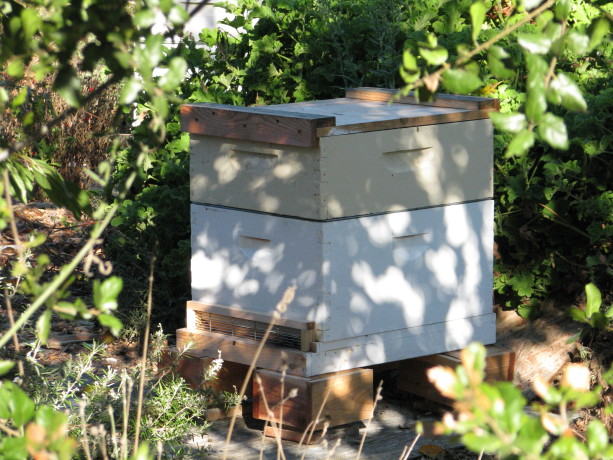
Beehive warming up. 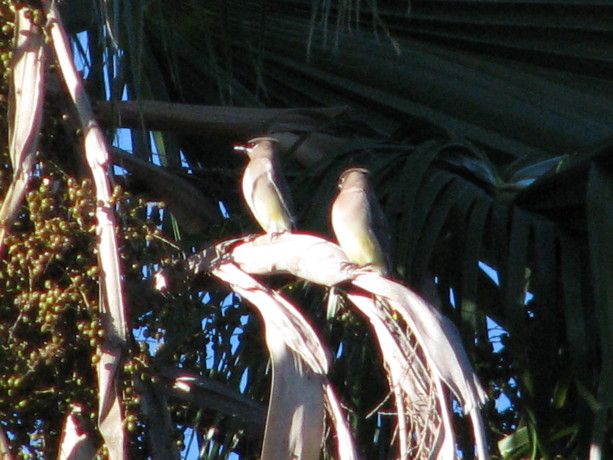
Ceder waxwings (my favorite bird) in the big palm. 
The Bee Garden. 
The liquidambers, also known as sweet gums, are just beginning to turn color. Lots of deciduous trees means lots of leaf mulch, and more warmth reaching the ground during the winter. 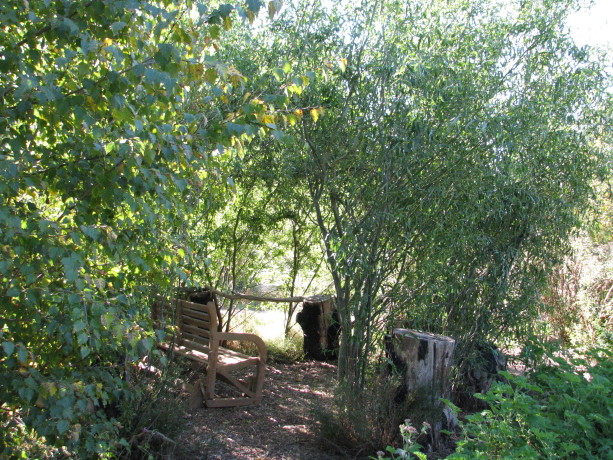
The entrance to the withy hide, with the pond in the distance. 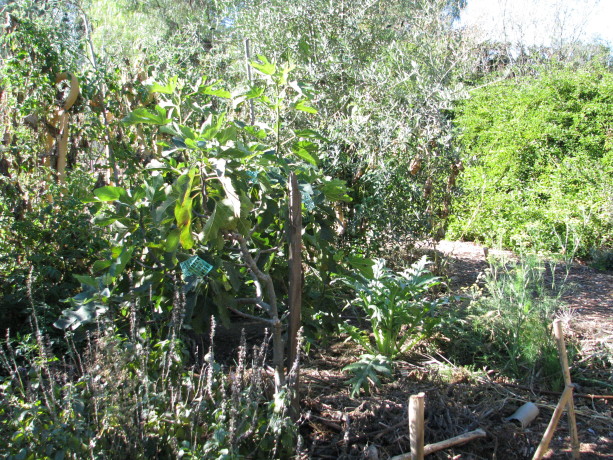
The Mission fig,with artichoke, anise and sage.. 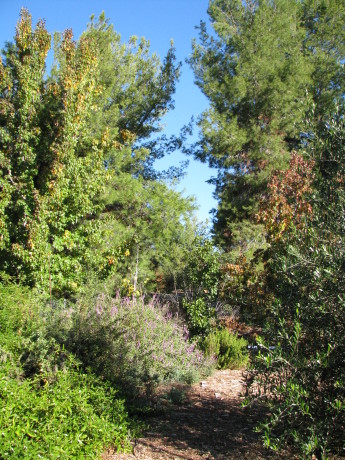
The canopy is growing. 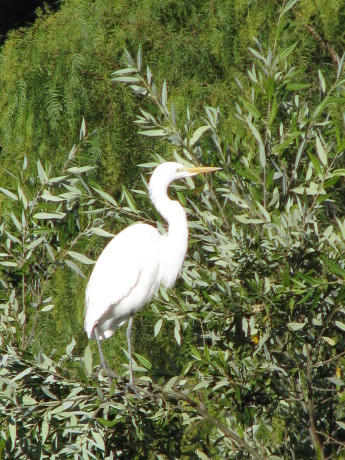
Greater egret enjoying the sun. - Animals, Chickens, Cob, Compost, Composting toilet, Fruit, Gardening adventures, Giving, Grains, Health, Herbs, Houses, Hugelkultur, Humor, Living structures, Natives, Natural cleaners, Permaculture and Edible Forest Gardening Adventures, Ponds, Rain Catching, Recipes, Seeds, Soil, Vegan, Vegetables, Vegetarian, Worms
San Diego Permaculture Convergence, Nov. 9 – 10, 2013
There is a fantastic, information-packed permaculture convergence coming up at the beautiful Sky Mountain Institute in Escondido.
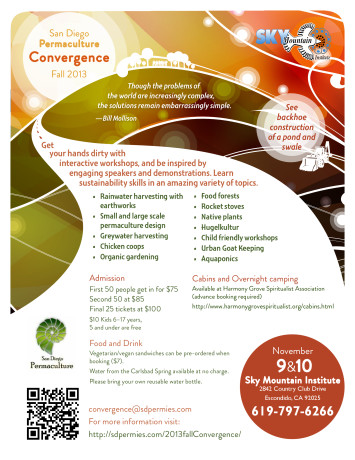 It will be two days packed with great information for a very reasonable price; in fact, scholarships are available. Check out the website at convergence@sdpermies.com. On that Sunday I’ll be teaching a workshop about why its so important to plant native plants, how to plant them in guilds using fishscale swales and mini-hugelkulturs. Come to the convergence and be inspired!
It will be two days packed with great information for a very reasonable price; in fact, scholarships are available. Check out the website at convergence@sdpermies.com. On that Sunday I’ll be teaching a workshop about why its so important to plant native plants, how to plant them in guilds using fishscale swales and mini-hugelkulturs. Come to the convergence and be inspired! -
Belle: Adventures of a Crossbill Chicken

Belle looks much jauntier than she is while being rinsed in her bath. When we added to our flock of five last March by acquiring chicks, we soon discovered that our Americauna (ironically already named Belle), was a genetic crossbill. Crossbill is a genetic mutation found particularly in Americaunas which causes the beak to scissor so that they don’t meet. Some unfortunate crossbills are affected so extremely that the hen eventually would starve to death. Because of the crossbill, the hens can’t peck at food.
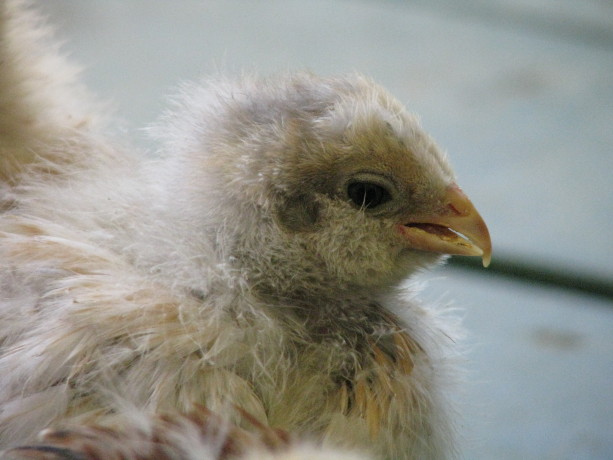
Aww! Belle as a baby. Sigh. So far Belle is able to eat, provided that we give her special food. We also use nail clippers and a nail file to trim as much of her beak off as we can without nipping the wick and making it bleed. Belle is very patient during the process. Mostly.
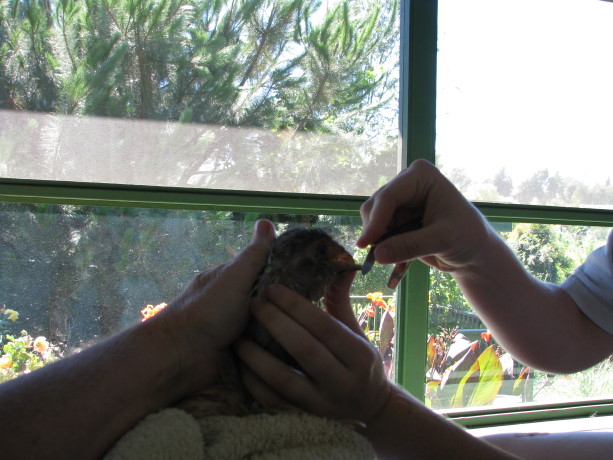
Gently and carefully trimming and filing Belle’s beak, keeping clear of the wick. She also can’t preen well. Preening in hens means that they dip their beak into an oil gland over their tail feathers and smooth that over their feathers, knitting them together and combing out the pin sheaths emergent feather shed as well as dirt and other itchy things.

Grooming is a challenge for her. Here feather sheaths and bits adorn Miranda after we finger-groom Belle. Belle’s food has to be mushy so that she can scoop it rather than peck at it. We grind up the foods we feed our other hens and then mix it with water until it has a scoopable consistancy.

Lay pellets, egg shells, oyster shell, cracked corn, and greens are ground up then mixed with water for Belle’s mush. We feed Belle the mush in a deep container with enough room for her twisted beak. Because the pecking behavior is so natural to her she finds it hard even with months of practice to scoop to the side. She shakes her head often but miraculously enough goes down.
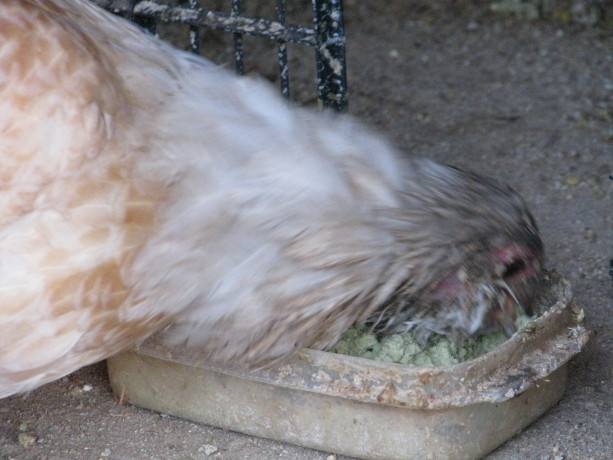
Belle’s eating habits are not a pretty sight. Although what we feed Belle is exactly what we feed the other hens, only wet, they still are jealous and will push her away from her food. So she is fed in a special upside-down milkcrate of my daughter’s design, in the upper portion of the quail coop (the quail won’t go upstairs). The door is closed to just a Belle-sized crack and held open with a sophisticated latching unit (a stick). Even so some of the bolder girls will invade.
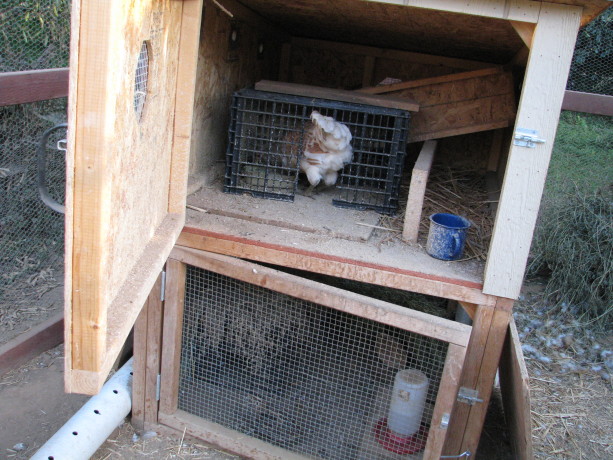
Belle eats upstairs in the quail coop. A crate helps keep her food from being raided by other hens. Some food does go down Belle’s throat, but much of it decorates the crate.
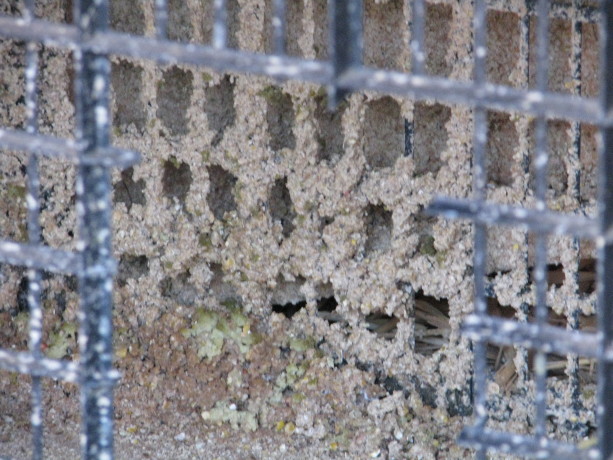
The wall of splatter inside her eating crate. After giving her a bath (as in the top photo) to soak off the dried hen food, her feathers looked so pretty (and she strutted around the porch so much as she dried) that I endeavored to find a solution to keep her clean. Alas, nothing worked. We ended up trimming her neck feathers to reduce the dried clumps.

I tried an old bib of my children’s on Belle to try and protect her clean feathers from splatter. It didn’t work. With all the handling Belle gets she has become a spoiled girl. She lives outside the hen’s pecking order, often scooting under their legs or pushing them out of the way when a treat comes even though she can’t eat it and has to have hers separately.
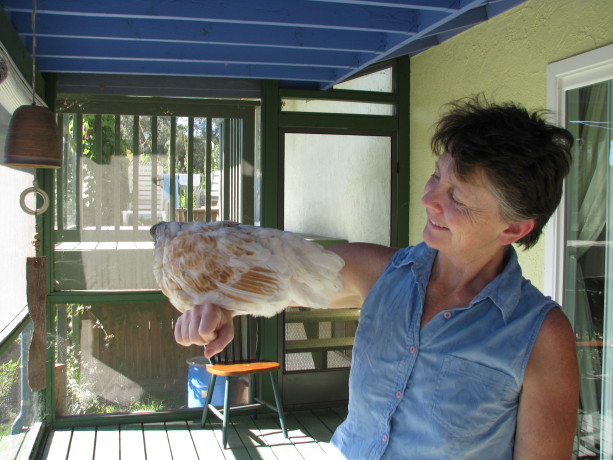
Belle, the falcon. Or the time is quarter-past Belle. Belle likes to help. I usually feed the hens in the morning while in my bathrobe. As I bend to scoop their food I find there is a chicken clawing her way up my back. She enjoys sitting on one’s head as well, particularly on my daughter’s as she has so much hair coiled up that it gives Belle a nice place, albeit an unwelcome one, to perch.
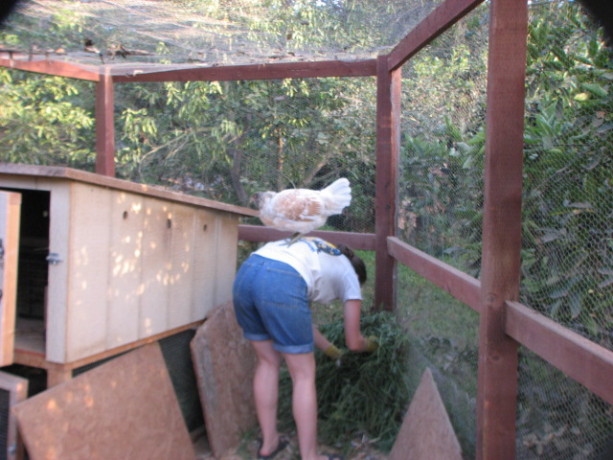
Belle likes to help whenever she can. When we fill Belle’s food dish with water outside the Fowl Fortress, she often sneaks under the door as it is closing and makes a leap for her food. Usually this results in food everywhere but in Belle’s very hungry stomach.
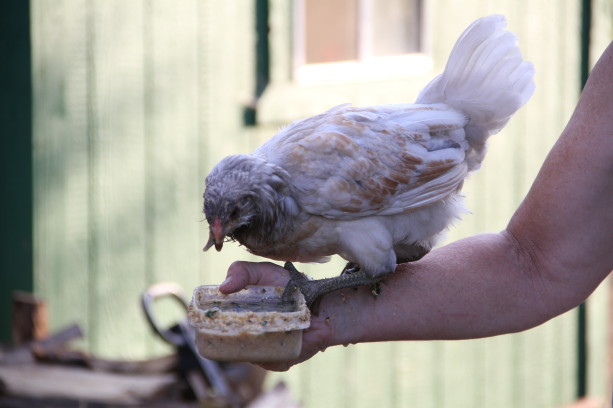
Belle usually can’t wait until she’s served. Belle is a happy chicken, eager for attention and enjoying being ‘teacher’s pet’. She doesn’t mind being carried around like a small football.
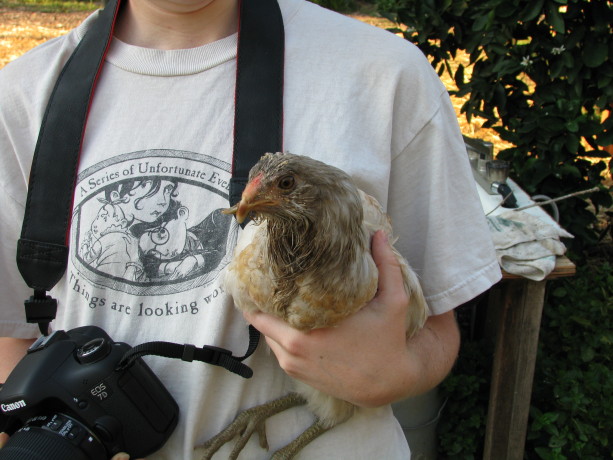
With all the frequent handling she gets, Belle enjoys being carried around… spoiled girl! After making fried zucchini for dinner one night I had extra beaten egg and soy milk left over. On a whim I cooked it into a custard for Belle. Well. I’ve never seen a hen eat so much. It was the perfect consistancy for her to scoop and it was tasty. Giving her a few day’s break I eventually made her a more nutritious custard. In my handy-dandy Vitamix (I really should be paid to sponsor them, although hen custard probably isn’t in their advertising scheme) I mixed quail eggs and their shells, lay pellets, ground cracked corn, oyster shell, buttermilk, and celery greens which I happened to have right there (from home-grown celery). The custard turned out very unappetising.
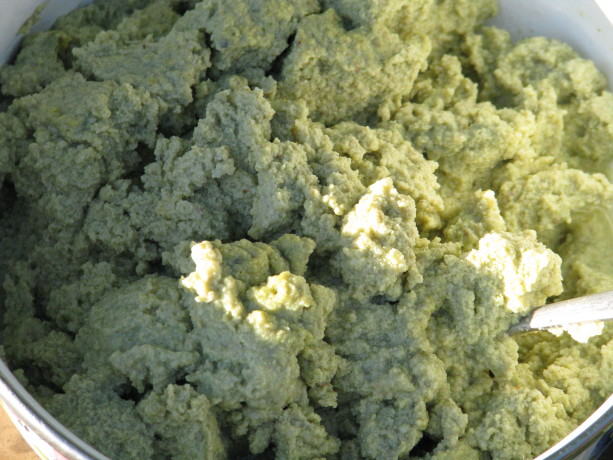
Although it looks like a cross between brocciflower and a sea sponge, it is really a dry custard. Apparently it was only unappealing to me and Miranda.

After-custard clean-up is necessary due to the dairy products. Belle’s not happy about being dabbed. It is worth the extra effort to insure Belle has a good meal and a full crop at the end of the day. When she’s full of custard she actually struts around the yard, happy with her fullness and the fact that she had a treat no one else had. Belle is of laying age but her size is smaller than the other hens and she’s still growing. I don’t mind if she doesn’t lay; she’s a darling friend and a neutral hen in the coop. I’m sure Belle will be the source of many more stories and certainly a lot more mess. Just another crazy, high-maintenance, unproductive little animal here at Finch Frolic!
- Compost, Gardening adventures, Health, Hugelkultur, Other Insects, Permaculture and Edible Forest Gardening Adventures, Soil, Vegetables, Worms
Don’t Clean Up, Dig It In!

Use old vegetables to grow new ones! Tomatoes, eggplant, peppers, fennel, carrots, string beans, three kinds of basil, and probably other things I’ve forgotten about! In January of this year I wrote about Lazy Composting. Frost had killed off sweet potato and tomato vines,
and the soil in the raised garden beds were becoming very low.

- Soil level is very low on the raised beds.
Instead of hauling all the vines to the compost heap or bin, I thought I’d create soil in place. The raised beds are lined with chicken wire to protect veggies from gophers. Although I didn’t want to disturb the microbes and fungus in the soil, I dug out half the beds down to the wire.
Then I layed all those vines right on the soil and covered them up.
Then I did the other half…
- Spent tomato vines, with some green ‘maters still attached.
… and then did the other bed. Any thick stalks in other beds which didn’t need extra soil I simply cut close to the ground so that their roots can decay in place and feed the wormies.
I sprinkled the whole thing with a little Epsom salts for the magnesium sulfate, and a little sugar to start the disturbed microbes feeding and reproducing heavily, which would cause them to decompose the vines more quickly.
In one bed I planted cold weather crops right away; peas, brassicas, garlic, onions and more. I am a firm practicioner of polyculture, or integrated gardening , which means that I plant an assortment of seeds of plants which will help each other in small areas instead of planting all one thing to a bed. I can still plant a row of peas so that I can string them up easily, but I’ll plant all kinds of other plants around them. Usually I don’t plant in a line at all anymore, but rather stake the plants as they need them. Often they’ll use taller plants as support. This is why planting peas and sweet peas next to trees and bushes is a great idea (they fix nitrogen in the soil which helps the tree).
In the other bed I waited to plant until March when the weather warmed up, because I was planting early summer crops. Here it is the beginning of September, and here are the beds, still producing. Even the winter veg one.
In the bed to the right there is a yellow current tomato blocking the view, and growing into the tree. You can see a Japanese eggplant, and behind it the red is a pepper. Under the tomato and along the bed are three kinds of basil, many string bean plants, some of the sweetest carrots we’ve grown, fennel (one of which we allowed to be the host plant for the Anise Swallowtail, which ate the tops. The bottom of the fennel, which is the part we eat, will still be harvestable). In the bed to the right is the January plants still alive and kicking. Collards, kale, garlic, celery, onions, brussels sprouts, kohlrahbi and more. We’ve harvested most of the garlic and onions. We’ve harvested kale, collards and celery by cutting leaves and allowing the plant to continue to grow. The stalks are now so thick that it is hard to cut them. Out of season, these plants have had attack by cabbage moths and other bugs, but because of the integration of plants and the health of the soil, they’ve bounced right back. I’m harvesting the plants now to feed to the chickens so that I can use the bed for something else soon.
So what happened? A teaspoon of great soil has a billion microbes in it, a million fungi, tens of thousands of amebas, bacteria and all kinds of things we don’t even know about yet. This is a good thing. This is the secret to continued life on this planet. Healthy soil doesn’t wash away, doesn’t erode, feeds the underground waterways, grows excellent food for healthy wildlife and healthy humans. If we feed the soil, we save the planet. That simple. That means no Roundup, no GMOs, no chemical (even organic) fertilizer. Just compost. Very cheap and easy.
Vegetables tend to like a soil that is heavier in bacteria than in fungus, although both should be present. Woody plants such as bushes and trees tend to like a more fungal soil. The vines that I buried had both dry (stems) and wet (green leaves and tomatoes) on them. The stems made the fungus flourish in the soil, and the green bits made the bacteria active. There wasn’t enough matter to become anaerobic, or to rob nitrogen from the soil. The vines weren’t compacted so lots of soil surrounded all the parts, aiding in quick composting and keeping the soil aerated. Water could be absorbed better as well.
If you are starting a garden and want to buy compost, be careful of what stores sell you. In August I was asked to look at a few raised beds that hadn’t succeeded. The soil was low in the beds, there were a few straggly pepper plants, a poorly tomato and some brassicas of some sort which were so stunted that they were just green balls of leaves. When I pulled one up there was white stuff on the roots. A couple of strawberry plants looked very healthy but unproductive. I tried the soil and couldn’t get my finger into it because the roots from those poor peppers had made a thick mat just under the surface of the dirt well beyond their dripline. Two major things were wrong. One was the dirt in the beds. Splinters of shredded wood made up the bulk of it. The woman who had asked me to look at the beds said that she had described her project at Home Depot and they’d recommended two kinds of bagged stuff. I say stuff, because it isn’t soil. What they recommended would be appropriate for hardwoods such as bushes and trees, or acid-loving plants. That is why the strawberries were healthy, only they were in the full sun in a searing hot place and would have done much better under the shade of other plants. I showed the white stuff on the brassicas to her; it was fungal net, which showed the high fungal activity in the soil. Perfect for trees, not perfect for vegetables. Also the brassicas are cold-weather plants and just won’t develop in our summer heat here in San Diego County. They should be planted from October through the beginning of March. The spongy soil… honestly, I’ve never before felt root mat so thick that I couldn’t wiggle my finger into the soil… was the result of desperate plants and poor watering. A custodian would occasionally hose water the beds, which meant that he’d shoot some water on them for a few minutes every day or so. This topical water didn’t sink into the bark-heavy soil. It was only enough to water the top, so the plant roots couldn’t go deep. It was often enough that the plants didn’t die entirely, but survived stunted and striving for water and nutrition that the fungal soil wasn’t providing. Vegetables (and roses!); indeed, most plants except grasses and seedlings, need deep watering less frequently. This allows the roots to go where they want to go, deep into the ground where they can mine nutrients and stabilize the plant. My advice for her was to dig in the few plants that were there, use the compost in the compost bin next to the beds, even if it wasn’t decomposed and add some vegetable-friendly soil to the beds to bring up the heighth. I recommended mixing seeds and scattering them, making sure she planted winter crops, not corn or tomatoes. I also recommended a long watering twice a week; none when it starts raining. If it ever does.
Recommending permaculture techniques to people makes me want to work in the garden! That is because there is so much life, so much success, so many happy surprises and such great feelings that come out of naturally planted gardens. Rows of veggies look so neat and peaceful, but beds chock full of veggies are more fun, better tasting and far more productive.
I just wanted to follow up on the old post about digging in the vines and show you how well the plants did. I have never fertilized these beds after burying the vines and sprinkling on the Epsom salts and sugar. All this growth is due to the happy microbes making nutrients available to the vegetable roots. If you think about it, plants in the wild shed their seeds and then either completely die off or drop leaves. The seeds naturally grow up through the debris of the last generation. Makes sense, doesn’t it?
When these beds are done (if they ever are! They keep producing!) I will practice no-dig gardening on them and simply cut all the plants at the soil surface and drop the tops. I’ll plant seeds for winter crops right in among the debris of the summer crops. They’ll use the nutrients, shade and support of the old crops to grow. October is a good planting time for winter crops because the weather finally changes and the daylight hours are shorter which these plants need. What to plant? Potatoes, garlic, onions, Brussels sprouts, cabbage, peas, broccoli, cauliflower, rhubarb, kohlrabi, celery and much more. Cover crops when it frosts and allow good drainage for the potatoes when it rains. Be sure if you buy starter sets that they are guaranteed organic! Best of all plant organic seeds… they do the best of all and are the best value.
Have a happy, easy Fall garden!
- Animals, Bees, Birding, Gardening adventures, Heirloom Plants, Other Insects, Permaculture and Edible Forest Gardening Adventures, Quail, Seeds
Growing Birdseed: Love Lies Bleeding Amaranth
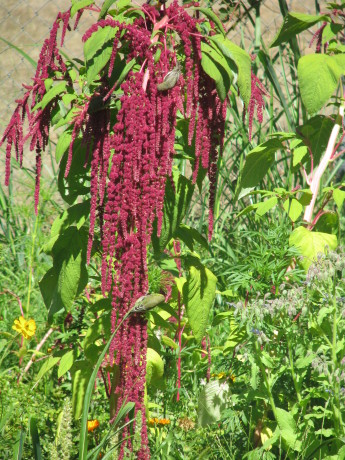
Love-Lies-Bleeding amaranth is a dramatic addition to your garden… ask a bird! We’ve participated in Cornell University’s winter Project Feederwatch for about six years. It is a volunteer amateur scientist-type program where, from November through March, you fill bird feeders and two days a week count how many birds come. Then you report your results on an online form. This helps trace changes in migration patterns and in habitats in wild birds, as well as sitings of diseased birds.
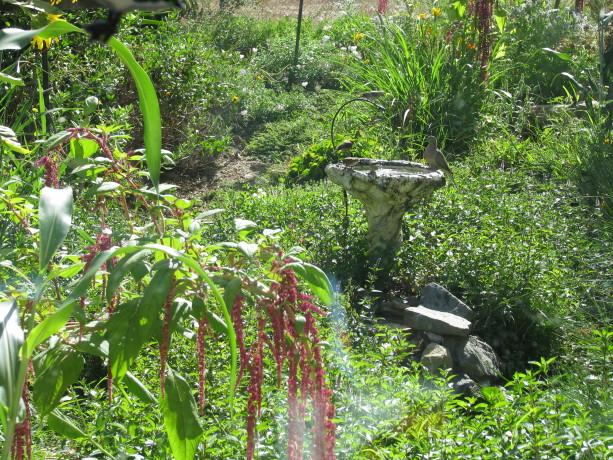
The sound of dripping water attracts birds more than food does… from long distances, too. This year I found out that most birdseed is contaminated by insecticide; some brands are reported to have illegal levels of pesticides in them. Geez! How am I going to get around that problem? I’m not sure about this winter, but I’m going to grow more of my own birdseed. In the past we’ve rolled pine cones in peanut butter and hung them out for woodpeckers and many other birds. I’ve also grown sunflowers, for both their seeds and for their leaves, which lesser goldfinches just love to eat! This year I planted heirloom Love Lies Bleeding Amaranth (Amaranthus caudatus) to some pretty spectacular results. Yes, this is one of the types of amaranth that produces an edible seed for humans; the leaves are edible as well. It can grow 3 -6 feet, with long ruby-red falls of seed heads that the birds just love.
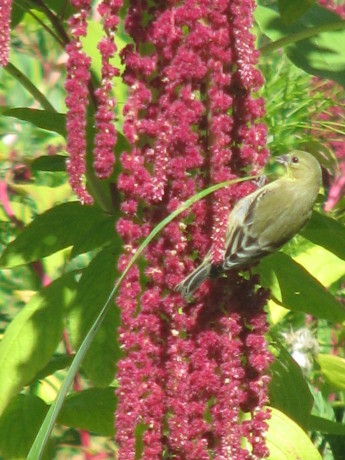
One of our Finch Frolic Finches feeding! There are many other amaranths to grow for both your own consumption as well as for the birds. Sometimes you grow it for yourself and end up feeding the birds! Of course there are many plants which attract hummingbirds all year, especially those with tubular flowers. Why do you want to attract birds? Besides their right to habitat, and their appeal to our better selves, all native animals play important roles in the preditor/prey relationship in a healthy garden. The birds may eat some of your produce, but they are also eating large amounts of bugs. They are also pooping, and you know how valuable poop is to any garden! If you plant a bird garden away from your vegetable crops, then plant your veg crops using the polyculture method, you will have birds and food for yourself as well. Please, please don’t put up those dangerous tree nets! They tear apart your trees when you try to remove them, they don’t really work, and birds can be stuck in them. When they are on the ground snakes are trapped in them! No plastic netting. Ever. Please!
Try planting some amaranth – especially this one with the dramatic name and dramatic fall of color – next spring when you plant a bird garden. Or in your edible forest garden and plant guilds. Or between your fruit trees, or along the back of your flower beds. Take a nibble for yourself if the birds will let you!
- Animals, Bees, Chickens, Health, Natural cleaners, Other Insects, Permaculture and Edible Forest Gardening Adventures, Pets, Quail, Worms
DE for Birds, and More About Chickens
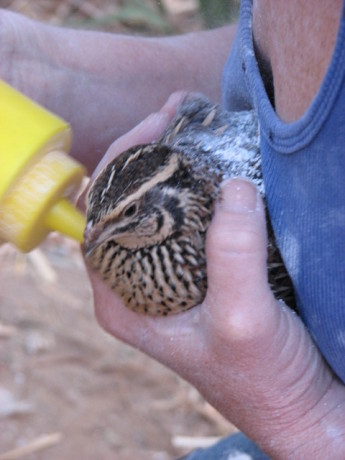
A little mustard with your quail? Cleopatra being treated. I’ve written about using Food Grade Diatomaceous Earth around plants to keep down ants and other sectioned insects. It is also used around the feet of my bee hives; as long as it isn’t where bees and other beneficials go it won’t hurt them because it has to be on the bug to work. I’ve also used FGDE around my cat’s bedding to kill hatching flea eggs, and have rubbed it into their fur. It is scentless, edible (will help kill interior parasites when eaten), tasteless, and the food grade is so fine that it won’t hurt your lungs if you breathe it in, although if you have lung conditions you should wear a mask. More about FGDE in a minute.
Some of our laying hens have difficulty laying eggs recently. Chickpea we found panting on the ground in a wet spot, with ants on her. She had a soft-shelled egg break inside of her.

Madge in the house cage, recooperating. Madge, our partially blind RIR passed a soft shelled egg, then was ill for a day when she passed a broken shell. Warm Epsom salts baths and time spent in the house cage with a heating pad helped both of them. Because of the threat of infection I used some of the Cephalexin left over from our dog (divided into small doses) on both of them and they recovered. My daughter finally deduced that in the mornings when the pullets and hens were released the big girls ran over to eat the chick mash. It probably tastes better than the lay pellets, and more importantly in their little brains it kept the pullets from eating it. Even with the supplemental oyster shell the big girls were probably not getting the calcium and other nutrition their bodies needed to make good eggs. It was time to switch the small girls to lay mash anyway, so I did and yesterday we had all four of our laying hens lay eggs… first time in a long time!
While we were bathing Madge in the sink for her illness, my daughter noticed mites on her. Now a few mites are usual on everyone and everything. When you can see several on the skin when you blow on the feathers, then you have a problem. She wasn’t having a problem, but at that time we still didn’t know what was wrong with her. After she was better we instituted FGDE Day in the Fowl Fortress.
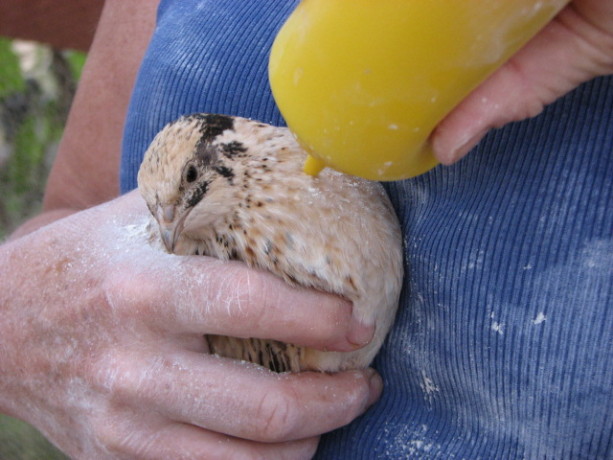
Miss Lemon, one of three coturnix hens, is treated with FGDE. You can buy pricey powder dispensers, which usually clog. I bought a set of mustard and ketchup dispensers for less than two dollars and they work just fine. We caught all the hens and our three quail and puffed FGDE into their feathers and, of course, all over ourselves.

We treat ourselves, too. I puffed it into the nesting boxes, and into the ‘attic’ of the pullet house where they roost, and into the straw in the coops. Since we don’t have a problem we don’t need to treat often, just every few months or so. Any that they eat helps with any internal parasites as well. We also had some wood ash left over from making pizzas in Harry Mud the cob oven and sprinkled them where the birds take dust baths. That fine ash helps to keep their feathers clean and keep away mites too.
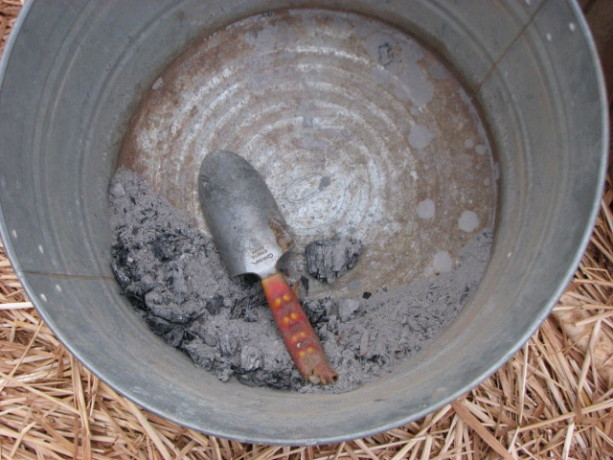
Wood ashes are good for dust baths. Very little went a long way, so even after treating all the hens and the Fowl Fortress, the cat bedding repeatedly, several cats, the feet of the bee hives, a variety of plants, and the feet of the food tables I’d set up for a garden party to protect from ants, along my window sills and around the privy where ants were getting in, I’m still working on the first bag that I bought on Amazon.com.
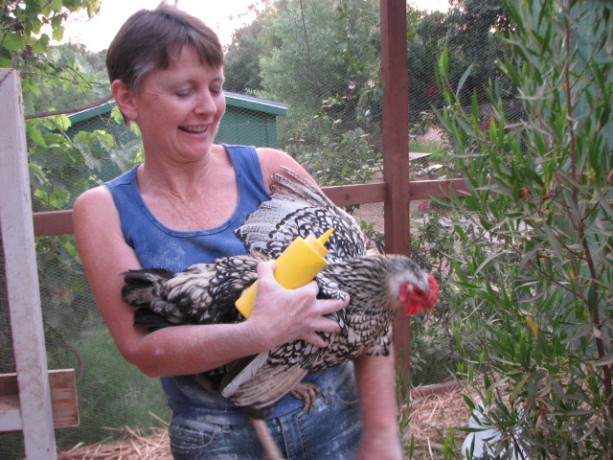
Amelia objecting to her dusting. When you compare with buying expensive different poisons for all of these problems, the health hazards and impact on non-target species including ourselves, and the negative impact on the Earth, one bag of FGDE is such a deal that you really can’t not try it.
-
Why Is July So Busy?
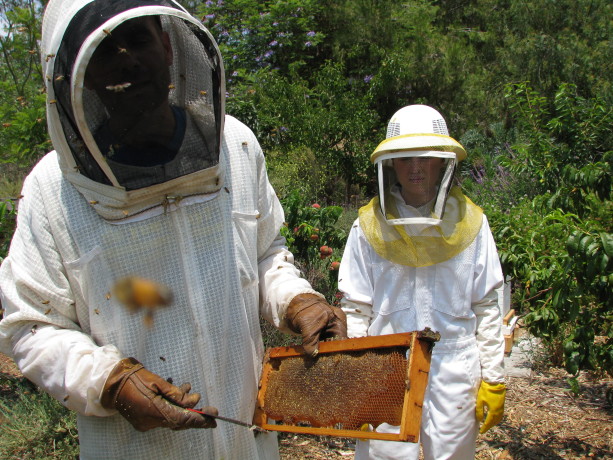
Quentin holds a frame full of wax-capped honey cells while Miranda looks on. Whew! What an early hot spell, and what a lot of things to do! The daylight is longer but animals, plants and people have a way of filling it all up. It is almost 9 pm again and still no dinner for humans this night. It is cooking. We’ve had a sick kitty, Maow, who we had to put to sleep due to kidney failure yesterday, and our ancient dog Sophie keeps us busy nursing her. She refuses dog food and only will eat veggie sausage and eggs, but none of our hens are laying in this hot weather. One of our chickens, Chickpea, had an egg break inside of her and had to have an Epsom salts warm sink bath which worked its chicken magic and pulled her through. Tonight our partially blind Rhode Island Red, Madge, has been acting funny so into the sink she went. The hens all like the warm bath so much that we don’t have to hold them down.
The garden produce has been good and keeping up with ripening fruit while beating the birds to it has been my newly graduated collegiate daughter’s role. Irrigation difficulties have created large problems, however, and lots of seeds never germinated, and several crops have shrivelled due to irregular or not enough water, while some others were drowning because of holes in the lines. Minerals from our hard water have clogged up holes in the lines, and running vinegar through the system seems to dissolve the calcium pretty well. If only it repelled the gophers who occasionally nip the underground lines, or the weeding tools that unerringly nick them.

Quentin and Miranda with one of the new hives of Italian bees put up two months ago. We have two co-op bee hives, set in place by Quentin Alexander of BeehiveSavers.com. He performs humane bee removal, and also has the co-op program where he sets up hives in your yard with calm Italian bees. You pay for the equipment, and he monitors the hive for a year to study the bees and see what is affecting the disappearance of European honeybees. He harvests the honey and gives you half of it, too. This is a perfect set-up for me since I just don’t have the time to deal with the bees anymore, and because I swell up when stung now. We had a swarm in a stack of empty bee boxes next to our trashcans for a couple of years and they never gave us any trouble, but I wanted to move them to the Bee Garden.

Quentin beginning to move a two-year hive that had settled in my stack of supers. The bees objected. When Quentin moved them a few months ago, he found out that they were an enormous ‘hot’ hive… pretty aggressive.
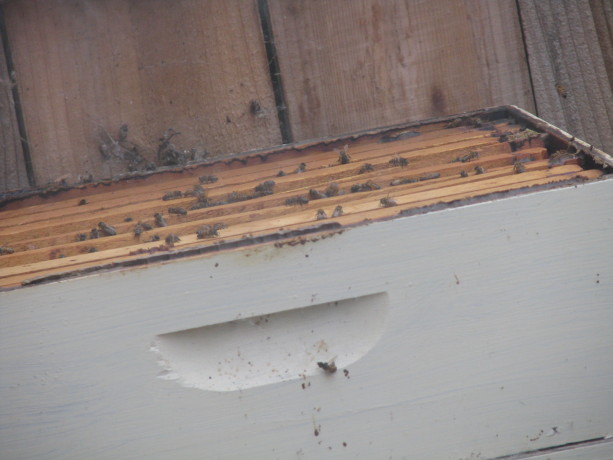
Bees complaining about having their home ripped apart… I can’t blame them. Yesterday he came with two ‘nuc’s, or ‘nucleuses’. A ‘nuc’ is a new queen bee and about a pound of workers devoted to her. With my daughter’s help, and with me hanging back with the camera, he opened the moved hive. It was breezy, humid, mid-day and in the 90’s, all bad conditions for opening a hive.
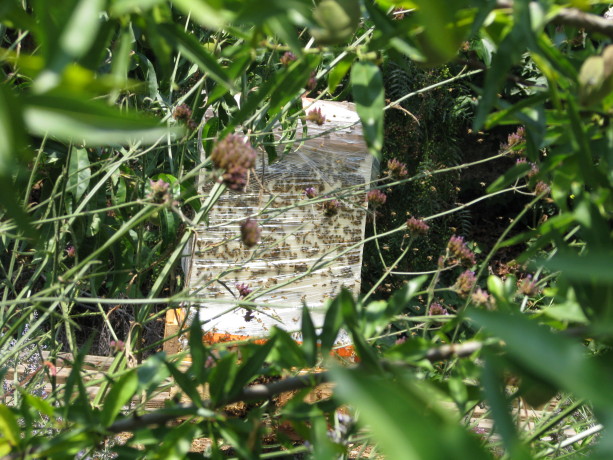
The wild hive wrapped with the ‘hot’ queen isolated in one of the supers by queen excluders. She will be replaced by a gentle queen. He looked for the old queen and couldn’t find her, so trapped her in one of the three boxes he thought she was in, moved honey and larvae over to two new boxes and set up the new queens. The idea is that the new kinder and gentler queens will breed more docile bees, and in a few weeks the whole swarm will not only have been divided into two but will have produced calm bees.
Explaining this to bees who were stressed from drought, heat, direct sunlight and humidity while tearing apart their hive, taking out brood and honey and looking to kill their queen, was a different story. A normal hive can have 60,000 bees or more in it at its peak. This was a larger hive. The bees decided that Quentin – and anyone else in the area – were going down with them. I don’t blame them. Attack my family and I’d come after you, too. Quentin’s gloves were studded brown with a forest of stingers. The neighbor called asking about bees because his gardeners were stung.

Miranda surrounded by very angry bees. No stings penetrated her bee suit, but on a humid day in the mid-90’s that suit sure was hot. We had to walk the property, roll in some jasmine to mask the ‘anger’ pheramone with which our bee suits were covered, and dash into the house. Quentin drove off in his suit with bees in his car – not an unusual sight for a beekeeper, but with the BeeHiveSavers logo on the side it looked very appropriate. We had to stay in the house until dusk when the bees went to bed (they don’t fly at night). Today the rest of the property was back to normal, but we did stay away from the Bee Garden for several more days. There are peaches to harvest in there, too, but we’ll have to donate some to the birds.
- Bees, Gardening adventures, Other Insects, Permaculture and Edible Forest Gardening Adventures, Seeds, Soil
Hairy Vetch
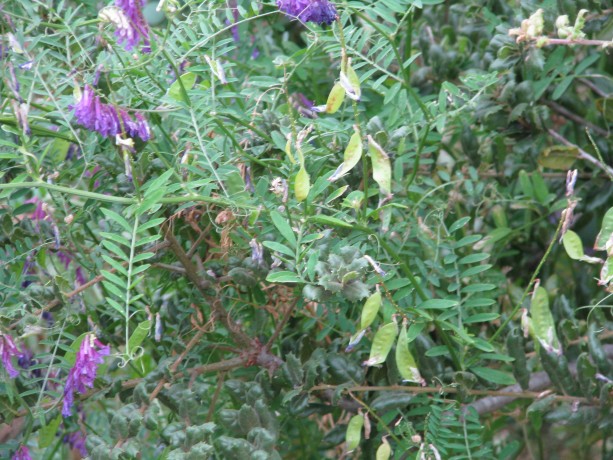
Attractive flowers and seeds. Hairy vetch (Vicia villosa), also known as winter vetch is a nitrogen-fixing plant that is used mostly for cover-cropping in monoculture fields. Native to Europe and Asia, it is a winter plant sown in the Fall and, in places where it snows, is killed off with the cold or tilled into fields. When a nitrogen-fixing plant dies or is cut back, roots die and release the nitrogen nodules into the soil. Here is sunny San Diego the vetch thrived since I sowed it in Spring of last year. It is a pretty, vining plant, with lovely dark purple blooms that bees and other pollinators love. It produces pea pods like its edible relative the fava bean, but I wouldn’t eat them. The seeds may be bad browse for livestock as well. The roots help hold soil during winter rains, too.
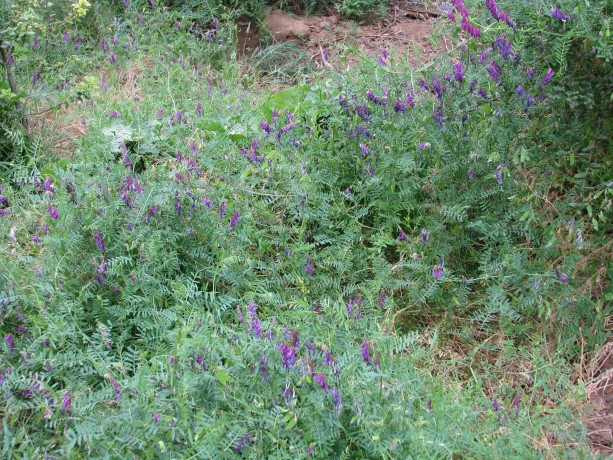
Hairy vetch clamboring all over the place Vetch can be hard to get rid of because it reseeds easily. It will also climb up bushes, competing with the bush for sunlight. If I didn’t know about the nitrogen-fixing properties and if the bees didn’t like it so much, I’d suspect it of being an invasive.
To control it I take my trusty hand scythe and cut the vetch out of bushes and close to the ground. I leave the vines to decompose and protect seedlings that I plant to take advantage of the newly-enriched soil.
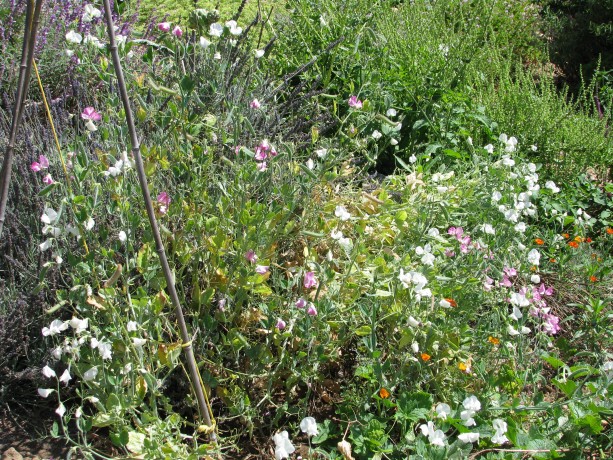
A mass of sweet peas climbing a lavendar. If you don’t want a cover crop that is so aggressive I suggest sowing a mixture of lupine, sweet peas, edible peas and fava beans in the Fall here in Southern California, and again in early Spring. In cold areas check with your farm advisor on when to plant.
-
Release of the Pullets, and No More House Chicken
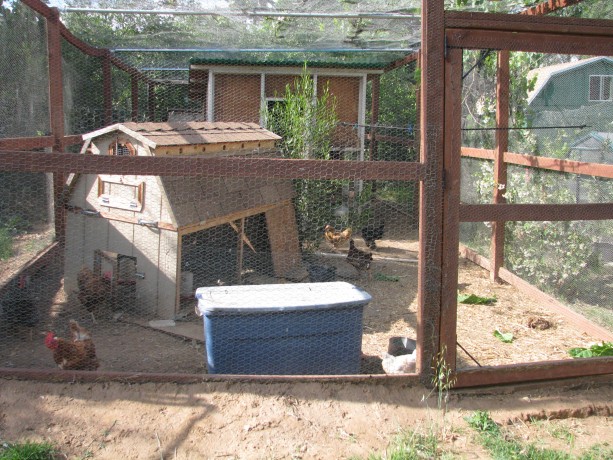
The Fowl Fortress and its many inhabitants. It was time. The little chicks were half-grown and beginning to eat scratch and pelleted chicken food along with their chick starter. They had finally figured out how to go upstairs at nighttime although it took several tries where I had to pick them out of their chick pile and shove them through the upstairs egg window. A couple of times when I’d let the big girls out into the garden, I had let the little girls out into the Fowl Fortress. They had run around stretching their wings and barreling into one another. So it was time for them to join the big girls as one large flock.

Four of the seven little girls. L-R: Belle, Charlotte, Esther (or Myrtle. They look and act the same), and Mulan (please don’t be a rooster!). And then there was Viola, the house chicken. She’d been a house chicken for over half a year, enjoying her special front yard paradise, coming when called, stealing some dog and cat food, caging herself at night, and crooning away whenever I sneezed or made noise while she slept. I really loved to have my house chicken. However she was alone a lot. She protested her aloneness by shrieking horribly for long periods of time. She could shriek with both exhaled and inhaled breath so that the noise didn’t stop. Even when at the end of my rope I yelled at her to shut up, she shrieked. She was becoming a spoiled and lonesome chicken. Her leg, the reason for her separation from the flock, was doing well again. I thought that if there was ever a good time to reintroduce her it would be at the same time that I let loose the little girls. There would be less hostility against Viola when the hens reinforced their pecking order. It was a very hard decision to make, but I thought it was for the best. I left the cage up in the house, though, just in case.
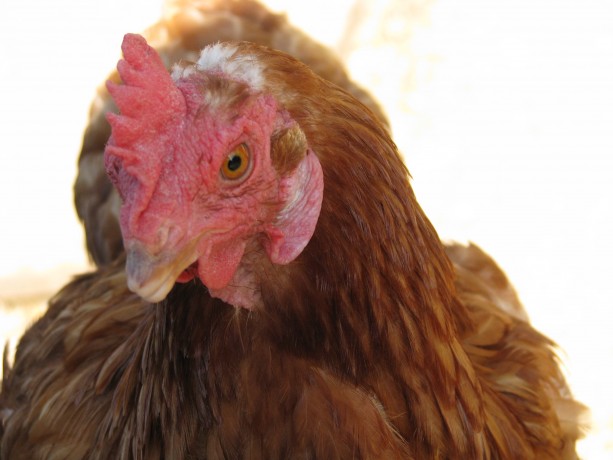
Madge: not just a rescue anymore! Uber hen! Last week I gave Viola a surprise and brought her down to the coop when I let the hens out of their chicken tractor. Viola wasn’t happy about it. Immediately Madge, the one-eyed Rhode Island Red who had been caged with Viola at the feed store when both had been seriously pecked, who had been her only friend for a year with my other girls, decided to punish Viola for her absence and make sure she knew she was at the bottom of the pecking order. She didn’t just give Viola – who is smaller – a peck, she tried to remove feathers. She jumped her and chased her. I had to get between the two of them. Pushing the vicious Blind Pirate Madge away just made her more intense, so I tried picking her up and giving her attention.
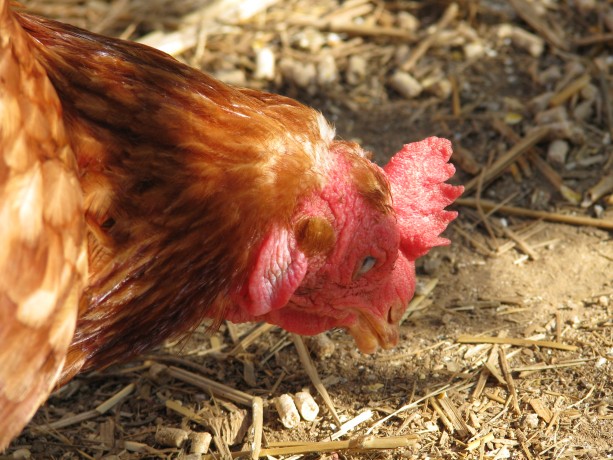
Paritally blind Madge… who’d have thought that she’d give the others the fish-eye? That worked better. Still, Viola had to hide. With Viola between my legs for protection I released the little girls.

Viola staying close. L-R: Madge’s butt, Malaika, Esther (or Myrtle), behind is Bodacea, crouching is Belle, Charlotte, in the back is Myrtle (or Esther), Mulan, and on the right is Lark. Not pictured: Chickpea and Miss Amelia, the flock leader. The big hens… pretty much ignored them. The little girls were so happy to be free. I kept their food inside their coop and propped the door so that only the smaller birds could get in there, but the big girls managed to shoulder themselves in anyway.

Madge shows her ranking to Myrtle as others look on in alarm. Lark, the Barred Rock who has been barren since she survived egg binding and who has been enjoying her work-free status has developed some kind of uncomfortable swelling. At first I thought she was just fat, but her tummy swelled like a balloon over several weeks. She lost her feathers on her red rump.
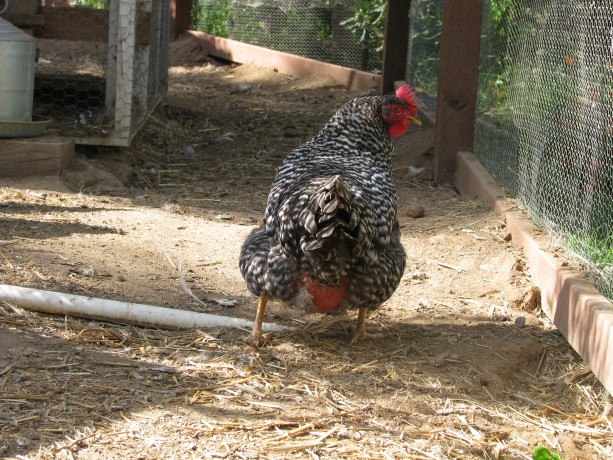
Lark’s uncomfortable ailment. It became awkward for her to walk so I gave her a couple of Epsom salt baths in the kitchen sink, and she became a house guest for a couple of days. She wasn’t as pleasant as Viola, but enjoyed the new experience. I returned her to the coop, and just today the swelling seems much less, thank goodness. The whole illness has not, however, affected her appetite.
Belle, the crossbill Americauna, had such difficulty eating that she is smaller than the rest and seemed to always be famished.
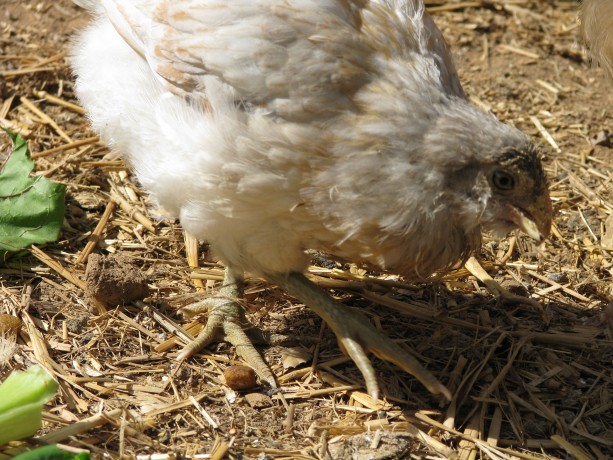
Belle, the Americauna who has the cross-bill trait. Small but sassy, and usually covered with mash. I finally found a small, deep tupperware container that I could wedge between a piece of wood and the side of her coop where it wouldn’t tip over easily, and filled it with chick starter and water mash. Belle was eating heartily for the first time since her bill began to cross and for once she had time to spend goofing around with a full tummy. And a messy face and breast. Since I’d tried trimming her beak, and since I make the magic mash for her now, she has become not only an energetic chicken but a devotee of me. While the other ingrates run away as if I were an axe murderer rather than the vegetarian that I am, Belle flies onto me at any chance. With Viola between my ankles and Belle running up my back I feel very much a part of the flock.

Ah haz a friend!
